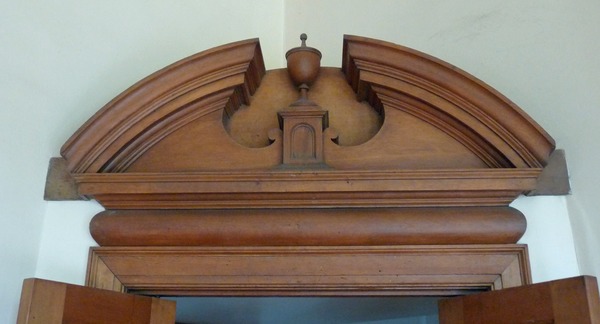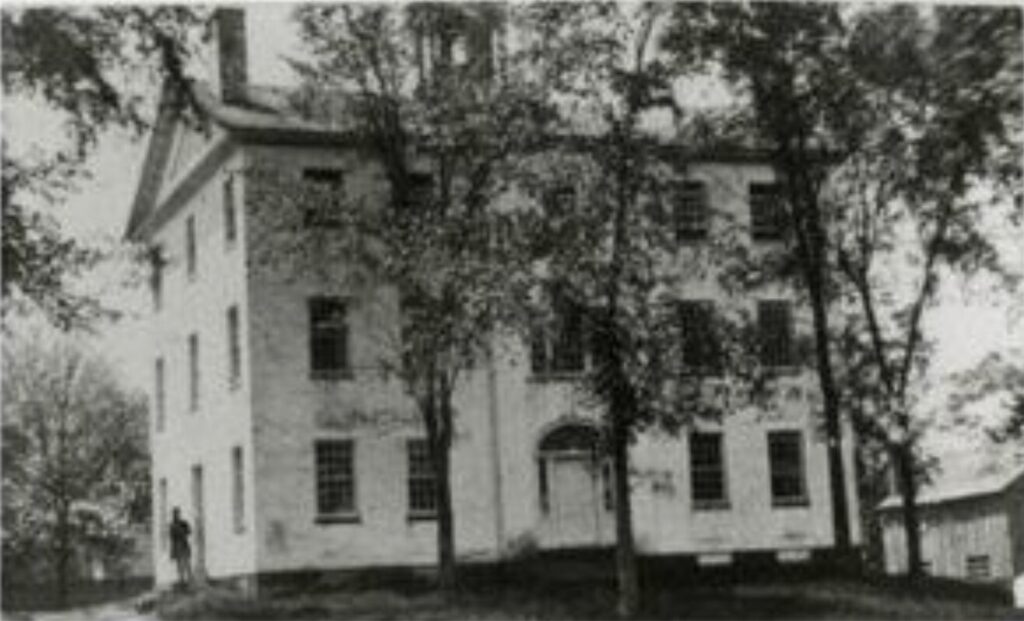Amherst History Month by Month: Amherst’s Educational Institutions. Part 4

Doorway inside the Assembly Hall, of the Munson Memorial Building. Photo: Carlos Heiligmann, Special Collections, University of Massachusetts at Amherst
See the following for Part 1, Part 2, and Part 3. Look here for a listing of all previous Amherst History Month by Month columns.
I’d like to take you on a little tour this month, exploring the outer edges of our town in terms of some of our many educational institutions as well as a gem of a building in South Amherst. As I’ve previously focused mostly on the architecture of UMass and Amherst College in these columns, it seems only fair to balance the scale in favor of other places that over the centuries have made (and continue to suggest that) higher learning is one of the main identities of our town.
The tour starts in the northern part of town — not North Amherst as such but Mount Pleasant, the name given these days to a distinctive, dead-end street that was once a grander place on the north side of Kendrick Park in Amherst center. One view of this visibly hilly area is from the Methodist church known now as Mercy House, that began life on Main Street in another building now known as the NACUL center. Above Mercy House is a sprawling home that was once a hostel for acolytes of the church. Other large stick-style and Colonial Revival homes on the hill might reinforce the impression that this is a very picturesque area, especially with its few gently winding roads that offer views of the rest of the town and of UMass.
In a past era, it was here that a couple of institutions dedicated to teaching and learning used to exist, including the Mount Pleasant Classical Institute and a later school for boys. The Classical Institute school operated at about the same time as Amherst Academy, a more famous school that had only one location – on Amity Street, so very much embedded in the heart of Amherst Center. Amherst Academy helped to sow the seeds of Amherst College. While Amherst Academy was founded with the help of Noah Webster (of Webster Dictionary fame), the Classical Institute further north, at Mount Pleasant, was founded by two Amherst College graduates. Not to get too side-tracked – Amherst Academy graduated luminaries like the writer Helen Hunt Jackson, the founder of Mount Holyoke, Mary Lyon, and the poet, Emily Dickinson. Samuel Minot Jones, founder of the Jones Library, also went here for his education from about 1847 until 1851. The school shut down in 1861, around the same time as the Civil War broke out.

Mount Pleasant Classical Institute began in 1826 and all that exists of it today is the grove of chestnut and oak trees that surrounded it. The school had 68 pupils between the ages of 6 and 12, of which the most famous young man was Henry Ward Beecher, the brother of novelist Harriet Beecher Stowe. It was a private school, relying entirely on fees, and only lasted five years, closing in 1833. Parts of its original neo-Classical building were then moved to Pleasant Street, where they became known as “the Beehive”, and the central, ancient Greek temple-like section was converted into a boarding school for boys that was destroyed by a fire in 1927.
On the way to our destination in the most southern end of our town, I want to share my newfound love of the Munson Memorial Library, the “Baby Jones” library, if you will. This is the Amherst library of choice for many people, even if they don’t live in South Amherst. I think I may well be visiting it more, especially while the “Mother Jones” demolition and construction project comes to fruition.
Dedicated as a branch library – by the Jones Library in October 1930, the Munson Memorial Building is several things at once. It was designed by Karl Scott Putnam, who also designed several buildings at Smith College, where he taught on the faculty until 1952. The Munson, built in the Colonial Revival style, is named in memory of Parnell Munson, fulfilling the terms of the bequest of his widow, Mary Munson. The property has a library, meeting rooms and an elegant, attached assembly hall.
Back to our tour, and from South Amherst Common, tracking west to the edge of South Amherst, we get to the junction of West Bay Road and South Pleasant Street, and find ourselves at Hampshire College. As one of the younger of Amherst’s many educational institutions, Hampshire was founded in 1958 when “the presidents of Amherst, Mount Holyoke, and Smith Colleges”… “appointed a committee to re-examine the assumptions and practices of liberal arts education.”
Instead of the Victorian mind-set of a young person being ‘formed and raised’ by “the best” of families, and/or a preferably Protestant church and Sunday school, along with some Yankee pride in the dignity of labor, the tone over a hundred years later had changed dramatically. Hampshire College’s more secular ethos was based on newer concepts; young people at the College were going to embrace “a lifelong passion for learning, critical inquiry, and ethical citizenship.” The founders hoped that this goal would inspire students to contribute to knowledge, justice, and positive change in the world. The college opened in 1970 on 800 acres of woodland, orchards, and farmland at the base of the Holyoke range.
The college continues to operate a working farm, as well as hosting the Eric Carle Museum, the Hitchcock Center for the Environment, and the Yiddish Book Center. Its athletic teams are known as the Black Sheep (cute and appropriate). From an architectural history perspective, it has one of the largest groupings of modernist, congregate housing in Amherst, so watch this space. ~

What a wonderfully wide-ranging romp through 4 centuries of Amherst educational architecture!
Thank you! And thanks again for all your information and links and resources that would yield a column about the various buildings associated with both the Rail trail/bike trail and its history. Bill Gillen was telling me that the Red Barn music school on Main Street used to be some kind of warehouse for the railroad (and close to the old Hills manufacturing company).
Thanks for this interesting and fun article, Hetty. My 2 things to add: 1) the Munson Library is a gem with terrific staff and free candy; and 2)I’m pretty sure that the Eric Carle Museum owns it land and it was a gift of Hampshire College.
Hello Janet! I am hoping to get to the talk about ice-harvesting at the Munson on Sunday afternoon. And this time, see the larger assembly hall where I imagine the talk will be held – its part of Winterfest! (icicle emoji here). Hetty